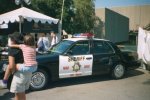Sheriff's cruisers take on black-and-white look
By Christina Jewett - Bee Staff Writer
Published 12:00 am PST Thursday, December 14, 2006
Story appeared in METRO section, Page B1
Print | E-Mail | Comments (18)
The Sacramento Sheriff's Department is switching to black-and-white squad cars in hopes of making the force appear to be everywhere all the time. Sacramento Sheriff's Department
What's black and white and seems to be all over?
Sacramento sheriff's cruisers. At least, that's the desired effect.
Under a plan by Sheriff John McGinness, the department will gradually replace its white cars with black-and-whites, a move designed to make the force appear to be everywhere all the time.
"I want the perception to be that every time you turn around, there's a black-and-white," he said. "We want people to have one of two reactions: 'Oh, thank God, a patrol car is here,' or 'Oh my God, a patrol car is here.' "
So far, 14 black-and-white cars are patrolling the county, with 110 ordered to arrive in coming months, said sheriff's spokesman Sgt. Tim Curran.
In three years, the 350-vehicle fleet will be updated as cars are replaced when they hit 100,000 miles. The change comes at no additional cost, Curran said.
The return to retro colors is being seen across the nation, with departments in Wisconsin, Arizona and California adopting the traditional appearance, according to Ed Nowicki, executive director of the International Law Enforcement Educators and Trainers Association.
"It is retro, but I hope it's a permanent change ... not just a trend," Nowicki said.
Sacramento police have been behind the wheel of black-and-white cars as far back as officials can recall, said spokesman Sgt. Terrell Marshall.
McGinness, who was sworn in as sheriff in July, said he was inspired to call for the change after reading in a law enforcement publication that Costa Mesa police had good results after switching color schemes.
Costa Mesa Police Lt. Karl Schuler said he studied the history of police car colors to make a pitch to the Costa Mesa City Council to repaint and upgrade cars at a cost of $3,000 per car.
Schuler said the zebra color scheme first appeared in the United States in the 1920s, when nearly all cars were black. Officers painted the doors white to set them apart, launching a national trend.
Later, white cars came into favor, Schuler said. They are cooler in the heat. They grew popular in an era of community-oriented policing because they give off a "softer" image, he said. But there are problems with white cars, including the fact that they can be mistaken for private security cars.
Schuler said the Costa Mesa department rolled out new cars to achieve a uniform 45-car black-and-white fleet in 2004.
"People said, 'Where did you get all the police officers?' " he said. "(The cars) really pop out to your eyes."
McGinness said he hopes to see the same force-multiplying effect.
The department patrols the unincorporated county of about 600,000 residents -- including the city of Rancho Cordova -- with 490 patrol deputies, according to an audit of the department released in February.
Whether or not the new cars beef up apparent police presence, the newly elected leader likes the look.
"I think it's a better visual image," McGinness said.


